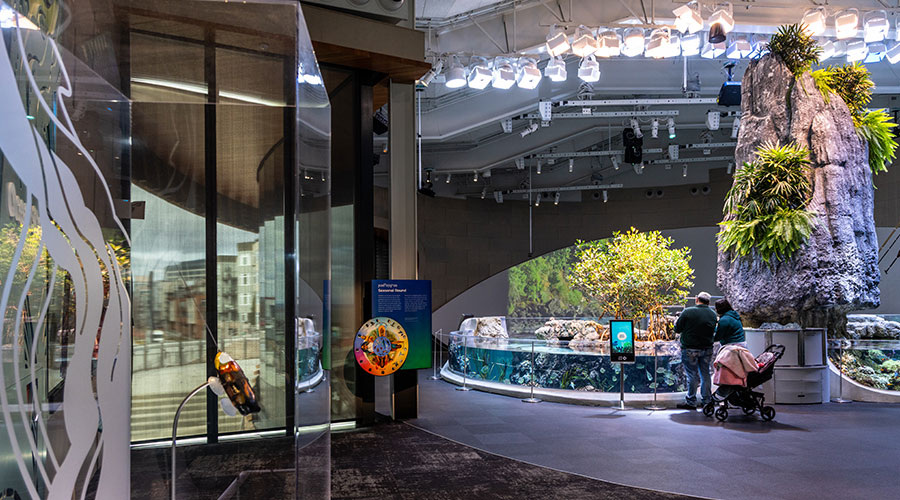Good Riddance to Old Lamps
Recycling used lamps, experts say, is the best way to keep mercury in fluorescent lamps out of the environment
As far as the environment is concerned, fluorescent lamps are a good-news, bad-news story. The lights save an enormous amount of energy compared to incandescent and certain other lamp technologies, reducing harmful emissions and reducing facility operating costs. But at the end of their lives, the lamps can have a serious but often overlooked impact on the environment: the release of mercury into the environment each time one of the fragile lamps breaks.
The mercury in lamps is invisible and volatile. But airborne mercury is deposited on land and in the water. A toxic form of the metal known as methylmercury can accumulate in fish and shellfish. At very high levels, mercury exposure can damage the brain, heart, kidneys, lungs and immune system. At lower levels of exposure — levels that can be produced by eating fish and shellfish — mercury can impair development in fetuses, babies and children.
The Environmental Protection Agency has placed standard fluorescent lamps into a category of hazardous waste known as universal waste. (See box on page 74.) Compared to other types of hazardous waste, universal waste entails less stringent standards for storing, transporting and collecting wastes. Other types of lamps — including high-intensity discharge and neon — may also contain mercury and be classified as universal waste.
Although it is the federal government that classifies used lamps as hazardous waste, the rules governing spent lamps do not come from Washington. “The waste regulations are at the state level,” says Hugh Davis, chief of the Waste Treatment Branch in the EPA Office of Solid Waste. “Frequently there are even county regulations.”
Because the laws governing lamp disposal vary across the country, experts caution facility executives to know the law in the areas where they have facilities. Eight states, including New York and California, have extremely rigid rules and do not allow any lamps containing mercury into landfills, says Paul Abernathy, executive director of the Association of Lighting and Mercury Recyclers (ALMR). Other states may allow disposal of lamps with small amounts of mercury, known as low-mercury lamps. Those states, in general, use EPA’s Toxicity Characteristic Leaching Procedure (TCLP) test, which was developed in 1990 to identify hazardous waste and is now used to determine whether a mercury-containing lamp is classified as hazardous.
“The best place to start is always with the state,” says Davis.
Although lamp-disposal options vary by state, industry and environmental experts agree that the best choice is to recycle the lamps. During the past five years, lamp recycling has increased. Currently, the recycling rate for businesses is a little under 30 percent, according to the National Electrical Manufacturers Association (NEMA). In 2004, approximately 670 million lamps were used in the United States, of which 525 million were used by businesses and other institutions, say NEMA statistics. Still, the business recycling rate is higher than the national recycling rate of 23.3 percent in 2004, which includes residential use.
Mercury in Lamps
Mercury is essential to the performance of fluorescent lamps. “Lighting manufacturers have not been able to find an energy-efficient substitute for mercury,” says Joseph Howley, manager, industry relations and environmental marketing, GE Consumer & Industrial. According to NEMA, a mercury-free fluorescent lamp would require three times more energy than one that contains mercury to produce the same light intensity. Nevertheless, many lamp manufacturers have developed ways to reduce the amount of mercury in lamps enough to pass the TCLP test.
Jennifer Dolin, environmental marketing manager for Osram/Sylvania, says lamp manufacturers have been able to reduce mercury in 4-foot linear lamps by about 80 percent during the past decade. Still, she says, all fluorescent lamps should be recycled, regardless of the amount of mercury. “When you throw them in the trash, you have a lot of mercury,” she says.
Steve Goldmacher, director of corporate communications for Philips Lighting Co., also recommends recycling. But he says it’s important for facility executives to consider the amount of mercury in lamps.
“We encourage recycling, but we know that all lamps are not going to get recycled,” he says. “And if you start out with the lowest mercury to begin with, you are less likely to have a problem later on.”
In an effort to assist with the recycling process, ALMR has created a listing of state-by-state information at its Web site. “Check with your state first,” Abernathy says. “You need to be sure what you do is legal in your state.”
The ALMR Web site also offers summary information about EPA regulations for fluorescent lamps.
Recycling Options
When it comes time to choose a recycling method, facility executives have several options. The most common are pick-up services, says Scott Beierwaltes, president of Air Cycle Corp., which offers a lamp recycling service and a lamp crushing system. The used lamps are packed into boxes or fiber drums, and a pick-up is scheduled with a recycling service. While this method is relatively inexpensive, it requires facility executives to store the spent lamps, which they can do for up to a year without a permit, Abernathy says.
As gas prices continue to rise, facility executives may find the most savings with this option, especially if they allow lamps to accumulate as long as possible and ship as many lamps as they can in one pick-up, says John McShane, general manager, national electronics recycling group for Onyx Environmental Services.
A second method is to use pre-paid recycling containers. Facility executives purchase the containers, pack up spent lamps and ship them to a recycler. While this is generally a more expensive choice, it eliminates the need for storage space, as a facility can ship used lamps immediately. The benefit to this method, says McShane, is convenience.
A facility may also have the option of crushing lamps using a controlled emissions lamp crushing system before passing them on to a recycling company. According to Beierwaltes, crushing lamps can reduce their volume by about 80 percent, reducing the amount of storage space necessary and possibly reducing transportation costs.
Crushing, says EPA’s Davis, is “extremely convenient. It can enhance recycling.”
But it’s important for facility executives to understand that the crushers are regulated at the state level. “In some jurisdictions they cannot be used,” says Davis.The reason is that some crushers have been shown to release mercury. “That is something we are concerned about, particularly if they are used indoors,” says Davis.
EPA studied crushers made several years ago and is preparing to issue a report with recommendations for the use of crushers. The report is expected out later this year or early next year. Davis says facility executives can use the recommendations to help evaluate crushers they’re considering. “Manufacturers have improved their products,” he says. Davis says some states may have information on crushers.
Facility executives who recycle lamps should do their homework on any firm that is processing the lamps. “Generally, recyclers are regulated at the state level,” says Jim Hattler, president of Mercury Waste Solutions. “At a minimum, check with the state compliance people.”
Beyond looking into the compliance record of the recycling facility receiving the spent lamps, Hattler also recommends that facility executives check the recordkeeping of the recycling facility. The recycler should have documentation to track a lamp from the time it is sent to the recycling facility to the point residuals from the spent lamps are shipped out. “Most of our largest customers do a site audit annually or every other year,” Hattler says.
Economics of Recycling
One question facility executives may have is why they should spend money to dispose of used lamps. “It’s hazardous waste,” Abernathy says. “Any hazardous waste you have is going to cost you to get rid of it.”
In many states, companies that send mercury-containing lamps to landfills could encounter penalties, including fines and other legal costs, as well as clean-up costs. Should a contaminated site be found years down the road, facilities may face expensive consequences.
“If they do not have proof they recycled the lamps, they could be responsible for the cost, or for sharing the cost of that site,” McShane says. “Recycling is almost like a good insurance policy when you think of the long-term potential costs.”
And the Costs Could Add Up
“All of this is quite expensive when compared to the low costs of just having the lamp recycled,” Beierwaltes says. “Why risk damage to the environment that will cause health problems for people, risk fines and potentially expensive clean-up costs when it's easy and low cost to do the right thing and just recycle them in the first place?”
The lamps disposal cost can, in the largest sense, be viewed as part of the lifecycle cost of the lamp itself. From that perspective, the cost of recycling used lamps is small compared to the expense of operating the lamps. According to NEMA, fluorescent and HID lamps are three to four times more energy efficient than incandescent lights.
Why does it cost money to recycle lamps when paper, glass and other items can be recycled for free? The reason, says Abernathy, is because there isn’t much value in the small amounts of mercury in each lamp, once isolated and recovered. As a result, recycling facilities are forced to charge for the service.
The recovered mercury, Abernathy says, “doesn’t come close to covering the costs (of recycling).”
What’s more, recycling is the environmentally responsible route to take, Abernathy says. “Mercury is everywhere, and it’s a big problem. Our position is all mercury lamps should be recycled. Whoever is making the decision to get rid of stuff has the responsibility to recycle light bulbs.”
Abernathy says that ALMR tries to work with facility executives because he believes they are key players in increasing the amount of lamps recycled. Not only do buildings generate the most used lamps, but facility executives choose the direction companies go with regards to recycling.
“They can influence the disposal decision more than anyone else,” he says. “It’s their building, their money, their responsibility.”
Laura Bayard is a freelance writer. Edward Sullivan also contributed to this article.
About “Universal Waste”
Many used fluorescent lamps are categorized as “universal waste,” a classification that covers such widely generated hazardous wastes as batteries and mercury-containing thermostats. Low-mercury lamps that pass the Environmental Protection Agency toxicity test known as the TCLP test are not classified as universal waste. Standard fluorescent lamps, which fail the TCLP, are subject to universal waste regulations; requirements for those lamps include:
- Used lamps must be packaged to prevent them from breaking while they are being stored or transported.
- Each used lamp or package of used lamps must be properly labeled.
- All releases from broken lamps must be immediately contained and any residues must be properly handled.
- Used lamps may be stored for one year.
- Facilities are required to train employees in waste handling and emergency procedures. Training requirements vary by the quantity of universal waste a facility generates.
- Facilities that transport used lamps are subject to rules for transportation of universal wastes.
|
Related Topics:












